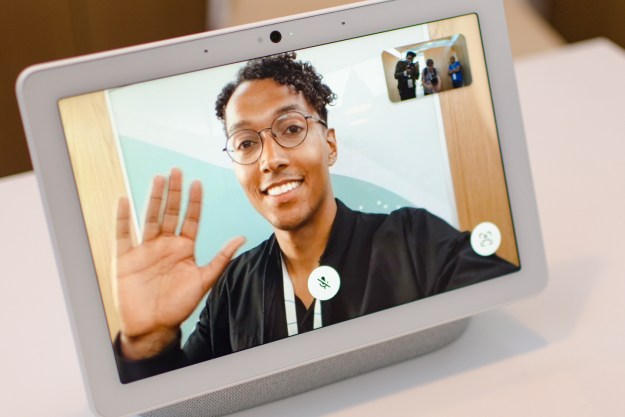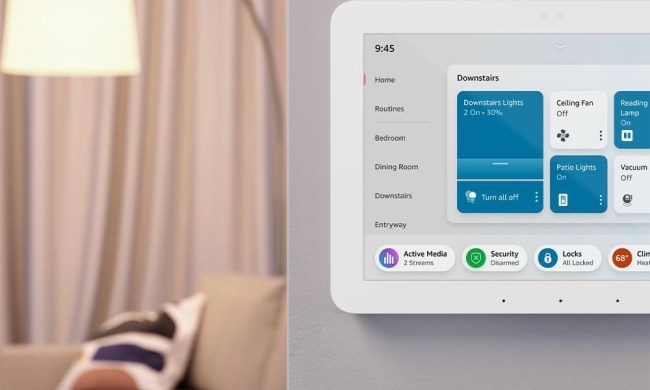
“The camera, not the screen, is why you'll want the Nest Hub Max.”
- Big, 10-inch screen
- Loud speakers
- Smart camera features
- Multiple ways to disable camera
- Access to Google Assistant, smart home control
- Takes up a lot of space
- Camera opens up privacy concerns
Google’s going through another major rebrand. Many of its smart home products — from the Chromecast to the Google Home Mini — will eventually use the Nest brand instead of Google’s own name.
To kick things off, the Google Home Hub is being renamed the Nest Hub, and it’s being joined by a new entry called the Nest Hub Max. It’s a bigger and better version of the Nest Hub, and the presence of a camera gives a whole new set of features that are genuinely useful.
I had a chance to see the Nest Hub Max in action at Google I/O 2019. Here’s what it’s like.
Bigger screen, better sound
The Google Home Hub – which we’ll now be referring to its new Nest Hub name – has a 7-inch screen, so it’s a little cramped for catching up on sports or shows. The Nest Hub Max fixes that with a 10-inch screen that offers 1,280 x 800 resolution. The bump in size makes everything easier to watch, especially when at a distance in the kitchen; it even becomes a better digital photo frame, because your photos look larger than ever.
Paired with this better screen experience are upgraded speakers. There are now two tweeters on the front of the Nest Hub Max, with one woofer in the back. The Google Home Max has one extra woofer, so it still maintains superior audio quality in the Nest/Google ecosystem, but the Nest Hub Max sounds very similar. The few music tracks we heard were extremely loud and had good bass. A longer listening session is required for further impressions, but it’s safe to say the Nest Hub Max offers room-filling audio that’s likely better than you’d expect.
Of course, the Nest Hub Max does take up a good deal more room than the Nest Hub. I’m already low on space in my kitchen, so I’d need to do some rearranging to fit it there, if not find another place in the house for the smart display.
The camera
The camera is the reason to buy the Nest Hub Max. The Nest Hub doesn’t have one, and for those worried about the camera snooping on you, it’s the better alternative. However, there is a physical switch that disconnects the microphone and camera simultaneously on the Nest Hub Max, as well as a way to digitally disable the camera alone so you can still use the “Hey, Google” hotword. When the camera is on, a green light on the front bezel indicates it’s in use.

With the camera, you can finally make video calls through Google Duo, which works with iPhones, Android phones, and even the Chrome browser. That means you can also leave video messages through Duo when people don’t pick up. Even better, while in a video call, the camera will pan and try to include you in the shot at all times, which is nice for when you’re moving around a room.
While video calling is much appreciated, there’s a new feature that steals the show. Face Match.
It’s a feature I’ve always wanted — the ability to pause media with just a gesture instead of having to say something out loud.
Face Match is an opt-in feature that lets you teach Google Assistant to recognize your face, and that of others in the household. It works like Google’s existing Voice Match technology, which helps Assistant recognize your voice. This allows Assistant to deliver personalized information to you and you alone, and not to anyone that asks it a question on the Nest Hub or Hub Max.
The same rings true for Face Match. All you need to do is stand reasonably close to the camera on the Hub Max. You’ll see cards populate the screen with relevant information, like your next calendar appointment or any Duo video messages you may have received. The face recognition technology reacts quickly, and it’s a nice way of keeping your data a little more private. That’s handy when you have guests over.
The camera can turn the Nest Hub Max into a Nest Cam security camera as well. You can check on your house through your phone and monitor if there are any disturbances, adding some extra utility to the Hub Max. This would require placing the Hub Max in specific parts of the house, of course, but you get the benefit of motion and sound alerts on your phone, and you can go a step further with a Nest Aware subscription to gain continuous video recording, familiar face alerts, and more.
The camera can also recognize gestures. Well, one gesture specifically. Showing the camera your palm will make the Nest Hub Max play or pause any media content. It’s a feature I’ve always wanted in other Google Home products, and it worked well in my demo.
A “Home Entertainment” tab lets you browse through channels to stream video.
That did lead me to start thinking about other kinds of gestures Google could incorporate. Google told Digital Trends it’s exploring other types of gestures, but the play/pause gesture is the only one that’s available for the time being.
Familiar Google software
The rest of the Nest Hub Max is in line with what we’ve seen on the Nest Hub. You can use Google Assistant to control your smart home products, or ask it any query. The interface lets you easily control specific smart home products as well, and there’s a “Home Entertainment” tab that lets you browse through channels to stream video.
Price and availability
The Nest Hub Max is $229 and will be available this summer from the Google Store. The re-branded Nest Hub will drop in price to $129 (down from $149).
The Nest Hub Max matches the Amazon Echo Show’s price range, and I think its smart camera features put it a step ahead — at least from the brief time I’ve spent with it.









